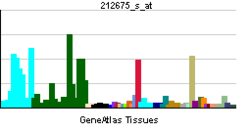CEP68
| Centrosomal protein 68kDa | |||||||||||||
|---|---|---|---|---|---|---|---|---|---|---|---|---|---|
| Identifiers | |||||||||||||
| Symbols | CEP68 ; KIAA0582 | ||||||||||||
| External IDs | MGI: 2667663 HomoloGene: 65235 GeneCards: CEP68 Gene | ||||||||||||
| |||||||||||||
| RNA expression pattern | |||||||||||||
 | |||||||||||||
 | |||||||||||||
 | |||||||||||||
| More reference expression data | |||||||||||||
| Orthologs | |||||||||||||
| Species | Human | Mouse | |||||||||||
| Entrez | 23177 | 216543 | |||||||||||
| Ensembl | ENSG00000011523 | ENSMUSG00000044066 | |||||||||||
| UniProt | Q76N32 | Q8C0D9 | |||||||||||
| RefSeq (mRNA) | NM_015147 | NM_172260 | |||||||||||
| RefSeq (protein) | NP_055962 | NP_758464 | |||||||||||
| Location (UCSC) |
Chr 2: 65.06 – 65.09 Mb |
Chr 11: 20.23 – 20.25 Mb | |||||||||||
| PubMed search | |||||||||||||
Centrosomal protein of 68 kDa is a protein that in humans is encoded by the CEP68 gene.[1][2][3][4] CEP68 is required for centrosome cohesion. It decorates fibres emanating from the proximal ends of centrioles. During mitosis, CEP68 dissociates from centrosomes. CEP68 and rootletin depend both on each other for centriole association, and both also require CEP250 for their function.[5]
References
- ↑ Nagase T, Ishikawa K, Miyajima N, Tanaka A, Kotani H, Nomura N, Ohara O (Feb 1998). "Prediction of the coding sequences of unidentified human genes. IX. The complete sequences of 100 new cDNA clones from brain which can code for large proteins in vitro". DNA Research 5 (1): 31–9. doi:10.1093/dnares/5.1.31. PMID 9628581.
- ↑ "Toward a complete human genome sequence". Genome Research 8 (11): 1097–108. Nov 1998. doi:10.1101/gr.8.11.1097. PMID 9847074.
- ↑ Andersen JS, Wilkinson CJ, Mayor T, Mortensen P, Nigg EA, Mann M (Dec 2003). "Proteomic characterization of the human centrosome by protein correlation profiling". Nature 426 (6966): 570–4. doi:10.1038/nature02166. PMID 14654843.
- ↑ "Entrez Gene: CEP68 centrosomal protein 68kDa".
- ↑ Graser S, Stierhof YD, Nigg EA (Dec 2007). "Cep68 and Cep215 (Cdk5rap2) are required for centrosome cohesion". Journal of Cell Science 120 (Pt 24): 4321–31. doi:10.1242/jcs.020248. PMID 18042621.
Further reading
- Nakajima D, Okazaki N, Yamakawa H, Kikuno R, Ohara O, Nagase T (Jun 2002). "Construction of expression-ready cDNA clones for KIAA genes: manual curation of 330 KIAA cDNA clones". DNA Research 9 (3): 99–106. doi:10.1093/dnares/9.3.99. PMID 12168954.
- Wistow G, Bernstein SL, Wyatt MK, Fariss RN, Behal A, Touchman JW, Bouffard G, Smith D, Peterson K (Jun 2002). "Expressed sequence tag analysis of human RPE/choroid for the NEIBank Project: over 6000 non-redundant transcripts, novel genes and splice variants". Molecular Vision 8: 205–20. PMID 12107410.
- Wang HY, Chien HC, Osada N, Hashimoto K, Sugano S, Gojobori T, Chou CK, Tsai SF, Wu CI, Shen CK (Feb 2007). "Rate of evolution in brain-expressed genes in humans and other primates". PLoS Biology 5 (2): e13. doi:10.1371/journal.pbio.0050013. PMC 1717015. PMID 17194215.
- Chen Y, Low TY, Choong LY, Ray RS, Tan YL, Toy W, Lin Q, Ang BK, Wong CH, Lim S, Li B, Hew CL, Sze NS, Druker BJ, Lim YP (Jul 2007). "Phosphoproteomics identified Endofin, DCBLD2, and KIAA0582 as novel tyrosine phosphorylation targets of EGF signaling and Iressa in human cancer cells". Proteomics 7 (14): 2384–97. doi:10.1002/pmic.200600968. PMID 17570516.
| ||||||||||||||
This article is issued from Wikipedia - version of the Sunday, August 02, 2015. The text is available under the Creative Commons Attribution/Share Alike but additional terms may apply for the media files.